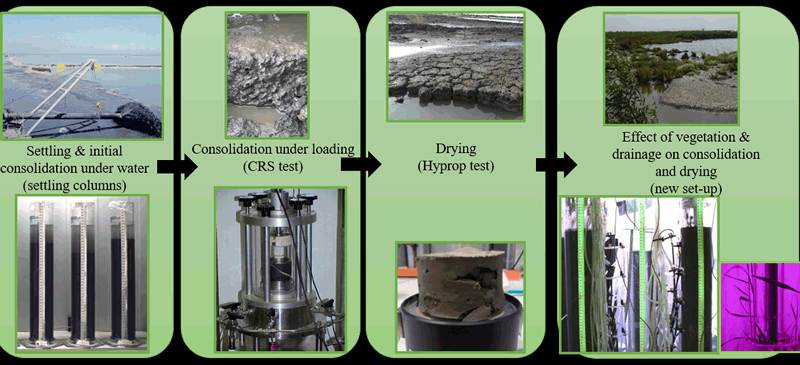Maria Barciela Rial*1, Johan C. Winterwerp 1, Jasper Griffioen2,3 and Thijs van Kessel4
1 Delft University of Technology, Department of Hydraulic Engineering -*This email address is being protected from spambots. You need JavaScript enabled to view it.
2 Utrecht University, Department of Sustainable Development, Faculty of Geosciences.
3 TNO Geological Survey of the Netherlands P.O. Box 80015, 3508 TA Utrecht, The Netherlands
4 Deltares PO Box 177, 2600 MH Delft, The Netherlands
Introduction
Sediment is becoming scarce and fine sediments are progressively used for reclamation projects. Therefore there is an increasing need to use cohesive fine sediments (mud) for land reclamation and nature building. These sediments exhibit larger deformations and consolidation time than sandy sediment, and are therefore more challenging building materials to use. The MarkerWadden (Lake Markermeer, The Netherlands) is one of the first projects using fresh soft mud (with a low-strength and high water content) for wetland construction.
In the research, the material properties of natural sediment from the Markermeer were determined and, the consolidation, drying and undrained shear strength was studied for varying solid compositions. Furthermore, the influence of vegetation and drainage during consolidation and drying was investigated.
Methods
The material parameters (of the previously characterised different sediment compositions) were determined with settling and Seepage Induced (SIC) tests. Further, multiple experiments were performed to study the behaviour of Markermeer sediment during the different construction phases (Figure 1). To study the consolidation behaviour under loading, Constant Rate of Strain (CRS) and Incremental Loading (IL) tests were performed. The undrained shear strength was studied with the Fall cone test. The commercial Hyprop device was used to determine the water retention curves (WRC) of the different sediments, therefore characterising their drying behaviour. Finally, a new set-up was designed to study the consolidation and drying under the influence of vegetation and drainage.

Figure 1 Some of the physical processes taking place during the construction of a wetland such as the Marker Wadden (top) and different experiments performed to study the response of the different sediments (bottom)
Results
The behaviour of sediment samples was dominated by the fine fraction for sediments below 70% sand. The results showed a strong influence of the type and degree of oxidation of the organic matter (thus not only of the amount) on the mechanic behaviour of the sediment. This effect was observed during all stages (settling, consolidation and drying). The vegetation induced high gradients and day-night pore pressure differences induced by plants as well as the change on the hydraulic conductivity of the sediment.
The results provide insight on the factors affecting the mechanical behaviour of mud. Therefore they provide engineering tools for Building with Mud projects, such as the quantification of plant drainage, while putting in relevance the importance of a multidisciplinary approach herein.










